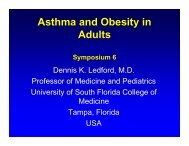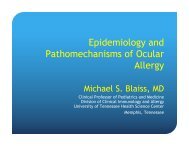scientific program - World Allergy Organization
scientific program - World Allergy Organization
scientific program - World Allergy Organization
Create successful ePaper yourself
Turn your PDF publications into a flip-book with our unique Google optimized e-Paper software.
118<br />
(salmeterol xinafoate/fluticasone propionate, dry powder for inhalation)<br />
(salmeterol xinafoate/fluticasone propionate inhalation aerosol)<br />
Bronchodilator and corticosteroid for oral inhalation<br />
ACTION AND CLINICAL PHARMACOLOGY<br />
ADVAIR ®<br />
(salmeterol xinafoate/fluticasone propionate) contains salmeterol<br />
xinafoate and fluticasone propionate which have differing modes of action for<br />
the treatment of COPD and reversible obstructive airways disease, including<br />
asthma. Salmeterol is a long-acting bronchodilator that prevents breakthrough<br />
symptoms of wheezing and chest tightness; fluticasone propionate is an<br />
inhaled anti-inflammatory agent that reduces airways irritability. ADVAIR ®<br />
can<br />
offer a more convenient regime for patients requiring concurrent long-acting<br />
ß2-agonist and inhaled corticosteroid therapy. The respective mechanisms of<br />
action of both drugs are discussed below:<br />
Salmeterol is a selective, long-acting (12 hours), slow onset (10-20 minutes)<br />
ß2-adrenoceptor agonist with a long side-chain which binds to the exo-site of<br />
the receptor.<br />
Salmeterol offers more effective protection against histamine-induced<br />
bronchoconstriction and produces a longer duration of bronchodilation, lasting for<br />
at least 12 hours, than recommended doses of conventional short-acting ß2-agonists. In vitro tests on human lung, have shown salmeterol is a potent and longlasting<br />
inhibitor of the release of mast cell mediators, such as histamine,<br />
leukotrienes and prostaglandin D2. In man, salmeterol inhibits the early and late phase response to inhaled<br />
allergen. The late phase response is inhibited for over 30 hours after a single<br />
dose, when the bronchodilator effect is no longer evident. The full clinical<br />
significance of these findings is not yet clear. The mechanism is different from<br />
the anti-inflammatory effect of corticosteroids.<br />
Fluticasone propionate is a highly potent glucocorticoid anti-inflammatory<br />
steroid. When administered by inhalation at therapeutic dosages, it has a direct<br />
potent anti-inflammatory action within the lungs, resulting in reduced<br />
symptoms and exacerbations of asthma, and less adverse effects than<br />
systemically administered corticosteroids.<br />
In comparisons with beclomethasone dipropionate, fluticasone propionate has<br />
demonstrated greater topical potency.<br />
Pharmacokinetics: There is no evidence in animal or human subjects that the<br />
administration of salmeterol xinafoate and fluticasone propionate together by the<br />
inhaled route affects the pharmacokinetics of either component. For<br />
pharmacokinetic purposes therefore each component can be considered separately.<br />
Salmeterol acts locally in the lung therefore plasma levels are not an indication<br />
of therapeutic effect. Because of the low therapeutic dose, systemic levels of<br />
salmeterol are low or undetectable after inhalation of recommended doses<br />
(50 mcg twice daily).<br />
Salmeterol is predominantly cleared by hepatic metabolism; liver function<br />
impairment may lead to accumulation of salmeterol in plasma. Therefore,<br />
patients with hepatic disease should be closely monitored.<br />
Following intravenous administration, the pharmacokinetics of fluticasone<br />
propionate are proportional to the dose. Fluticasone propionate is extensively<br />
distributed within the body. The volume of distribution at steady state is<br />
approximately 300 litres and has a very high clearance which is estimated to<br />
be 1.1 litre/minute indicating extensive hepatic extraction. Peak plasma<br />
fluticasone propionate concentrations are reduced by approximately 98%<br />
within 3-4 hours and only low plasma concentrations are associated with the<br />
terminal half-life, which is approximately 8 hours.<br />
Following oral administration of fluticasone propionate, 87-100% of the dose<br />
is excreted in the faeces. Following doses of either 1 or 16 mg, up to 20% and<br />
75% respectively, is excreted in the faeces as the parent compound. Absolute<br />
oral bioavailability is negligible (

















